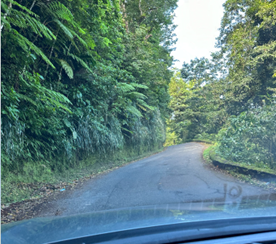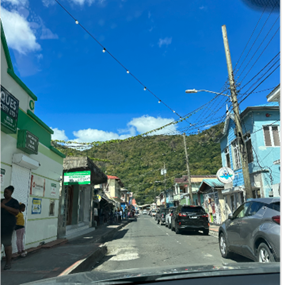“Waaaaahhhhhhahaaaa!!!”, my wife screamed, her hands white-knuckled the side of the car seat.
She was sitting shotgun in our tiny Suzuki rental when we came inches from a comically large and ancient delivery truck trundling mid-way through a blind curve.

It was a close call. One of many that day.
My kids oscillated between terror and laughter as we negotiated the cratered and winding roads of St. Lucia over the winter holiday. While most vacationers are happy to sit at a resort…my family quickly developed a bad case of wanderlust, so we stayed on the move.
While incredibly beautiful, the island’s roads are insidious. They are very narrow, winding, and with double-digit grades. On the side of the road, there are 3-foot drainage ditches that would surely tear your wheel off if you got too close.
On the opposite side of the road, you are usually confronted by a sheer cliff that would drop you directly into the Caribbean if it wasn’t for the abundant flora that happily hid most of the cliff face.

In most places the roads are so narrow that two small cars can barely pass in opposite directions without trading paint. There are no passing zones, so the locals take advantage of the very few straight-aways and pass at maximum speed, seemingly unphased by the number of near head-on collisions my entire family had witnessed on our short stay.
Other driving challenges presented included the locals’ tendency to wander out on the road throughout the island. While a paradise, vehicle ownership is not widespread, so walking is the main form of transit for many on the island and there is a paucity of sidewalks.
Driving around I reflected on the vehicle we rented. Even the small Suzuki with its diminutive stature seemed unsuited for island life. It was too big and overbuilt in some ways and underbuilt in others. This got me to thinking about how you might innovate and redesign a customer experience for island life vs. shoehorning the Western world’s available drawer of solutions.
Designing for Island Travel
While economies of scale might make it uneconomical to do so, it became immediately clear that our small Suzuki was not an optimal form of transit to mountainous islands (as most islands throughout the world are).
First, are the design factors that are constrained by the external environment. You can never achieve a speed more than 35-40 mph on the island (and I would not advise going any faster). Our Suzuki had an irrational maximum speed of more than 100 kph (about 60 mph) if one believed the speedometer.
The roads are incredibly steep and many places are pock-marked with holes that could accommodate an entire family of groundhogs. This puts great strain on tires, brakes, and thrashes suspension. I asked a local if the tire and brake business was good on the island.
Unsurprisingly he said, “Ya man. Real good.”
The roads are very narrow. Taking a normal vehicle found in any parking lot in the United States would be insanity. The infrastructure demands something much smaller and nimbler.
Moving beyond the geography and infrastructure is the weather. It’s normally gorgeous, never getting below 65 degrees or much above 80 degrees year-round. There is rain but it is fleeting…lasting never more than an hour or so as the Caribbean wind sends it on its way into the Gulf of Mexico. Do I really need an AC unit, a heater and to be encased in aluminum? There weren’t even bugs. Not that they could keep up with us if there were.
Finally, there’s fuel. Fuel is really expensive on the island at $5 – $6 a gallon. The island is powered by shipped diesel, so electricity is also very expensive. The median income of a St. Lucian is around $12,400, so fuel expense ways heavy on individual households that can even afford a vehicle. While the island is not large…they need a very fuel-efficient form of transportation.
What kind of vehicle would you design given these requirements? My guess is it wouldn’t be a Suzuki SX4…or probably any current automobile whatsoever. EVs are probably out as well. You would probably want a very torquey, nearly indestructible, small, open cab, ultra-efficient form of transportation.
While this vehicle probably doesn’t exist today, it might look something like an economically-priced side-by-side tuned to be ultra-reliable and fuel efficient. The point is what works on the wide expanses of the American mid-west are not suitable for island life. Even the vehicles that originated from the narrow streets of Tokyo seem unreasonably plush and over-engineered for tropical island use.
In fact, someday the St. Lucian Ministry of Transportation might conclude that cars on such a small island are kind of stupid and that a combination of micro-mobility, shared and public mass transit for non-commercial use makes more sense.
Context is Everything
It’s important to not only consider environmental factors in experience design, but also historical and cultural context.

I often get into friendly arguments with my Toronto automotive expert friend, James Carter, about the need for full-size trucks in North America. Growing up on an Australian farm in the outback, he has not been completely blinded by urban living. He’s quick to point out there are very few non-commercial gigantic mega trucks found on Australian roads even though it is more rural and equally expansive as North America.
His reasoning is, as I understand it, if you don’t need 1-ton duallies to do ranching in one of the most unhospitable places on the earth, why would North America be any different? Also, he rightfully points out, many of those inefficient gas-powered urban mall-crawlers don’t negotiate anything more treacherous than a parking curb outside of Nordstrom’s. These behemoths were much more vehicle than what is needed for the average Joe.
I think he has a valid point.
However, context has as much to do with history and culture as the present physical environment. Once you get out of the urban zones around major cities in the United States you start to see full-size trucks doing crazy stuff.
They are hauling massive loads of lumber to job sites, well above the recommended load limit. They are towing massive 2 and 3-axle trailers up the wide and winding roads of the Rockies through inches or feet of snow. So yes, there are quite a few mall crawlers, but there are also people using these trucks hard…often beyond the stated parameters in the owner’s manual.
We will probably continue to agree to disagree on that specific point, but there is a larger point to be made.
The very existence of 1-ton duallies in the United States as a personal vehicle is possible here because we created infrastructure to support their existence, we made them affordable enough for the American public to buy them, and we kept fuel costs and taxes to a point where they can operate within the grasp of most Americans.
The existence of these vehicles had the knockdown effect of creating stores where you can pick up a year’s worth of toilet paper and 10 years’ worth of laundry detergent at a discount. Where you can go and pick up 4 yards of mulch to spread on the landscape on our expansive properties. The recursive relationship between roads, vehicles, and activities allowed people to tow massive motor homes across the wide expanses of this country.
This also enabled and propelled a truck culture that is intertwined with the cultural fabric of the United States as much as hot dogs, guns, and baseball. For the last 30 years the best-selling vehicle in the United States has been the Ford F-150. Ford has sold more than 43 million models since inception. That’s one for every man, woman, and child in Canada, with a few million left over for their pets.
So, in this way, culture and history also play a role in design. Products and services are not born into an empty void. They are embedded in part of a larger ecosystem. Sometimes that ecosystem works well for a design…sometimes it doesn’t. An F-150 in St. Lucia is a no-go. The tiny 127-horsepower Suzuki SX4 driving on the 6-lane 405 freeway with class 8 trucks driving at 75 mph is not an optimal solution either.
Designing With Context in Mind
So, what are some good rules and practices to follow in ensuring design success for these systems?
First, as we have always advocated, it is about Genchi Genbutsu…which is a Japanese phrase meaning “go, look, see”. Excellent advice, but it is important that you go, look, and see the right things, too. As we saw this includes the physical and environmental surroundings, as well as the social, historical, and cultural context.
Solutions are embedded in this context and may or not work with it. This is not a dead end. The courageous are not content with accepting the larger eco-system. They attempt to change it. For example, Thomas Edison allegedly tried (and failed) to create a Direct Current future in a very dramatic way by publicly electrocuting Topsy the Elephant with 6,600 volts of alternating current[1].
Steve Jobs removed the keyboard from the phone and added a camera, games, and to the horror of some of his employees created an app store whereby other could write code for his product. This willful alteration of environment essentially put the market leader, Blackberry out of business.
Elon Musk had the foresight to see that remote charging was going to be an issue and was not at all convinced (rightfully so it turns out) that a partnership approach would work well, he started deploying his own Super Charging stations. Then, not trusting wireless carriers he decided to launch 10,000 satellites to help with navigation, communication, and general connectivity for the future of autonomy. Turns out both of those were very good ideas and now Tesla is the leader of electric vehicles in the United States by a far stretch.
Finally, in designing future solutions, it is important to escape the shackles of the here and now in favor of what is possible. We must unlearn what is. A car is not the optimal transportation solution for a small island any more than a golf cart is ideal for traversing small communities. There are opportunities in the dark areas of the unknown. It requires a bit of imagination and determination to figure out where those opportunities are…and what solutions will work best.
Ya man.
Notes
[1] This spectacle also reportedly was the catalyst for the invention of the electric chair by Alfred Southwick who felt that electrocution was a more humane form of execution than other alternatives.



